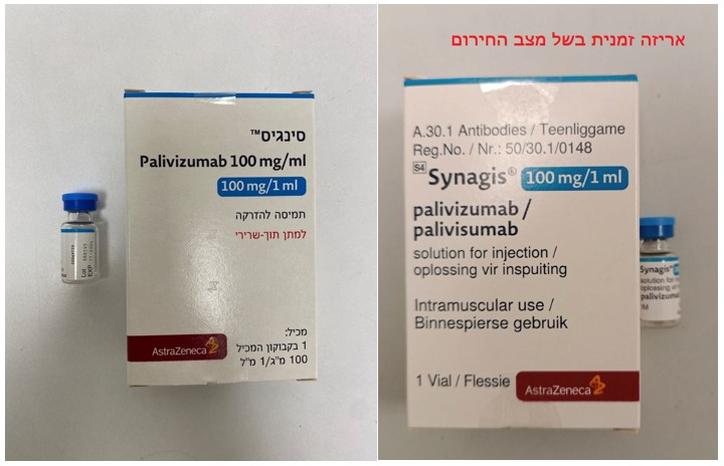Quest for the right Drug

סינגיס synagis (PALIVIZUMAB)
תרופה במרשם
תרופה בסל
נרקוטיקה
ציטוטוקסיקה
צורת מתן:
תוך-שרירי : I.M
צורת מינון:
תמיסה להזרקה : SOLUTION FOR INJECTION
עלון לרופא
מינוניםPosology התוויות
Indications תופעות לוואי
Adverse reactions התוויות נגד
Contraindications אינטראקציות
Interactions מינון יתר
Overdose הריון/הנקה
Pregnancy & Lactation אוכלוסיות מיוחדות
Special populations תכונות פרמקולוגיות
Pharmacological properties מידע רוקחי
Pharmaceutical particulars אזהרת שימוש
Special Warning עלון לרופא
Physicians Leaflet
Adverse reactions : תופעות לוואי
4.8 Undesirable effects Summary of the safety profile The most serious adverse reactions occurring with palivizumab are anaphylaxis and other acute hypersensitivity reactions. Common adverse reactions occurring with palivizumab are fever, rash, and injection site reaction. Tabulated list of adverse reactions Adverse reactions both clinical and laboratory, are displayed by system organ class and frequency (very common ≥ 1/10; common ≥ 1/100 to <1/10; uncommon ≥ 1/1,000 to <1/100; rare ≥ 1/10,000 to <1/1,000) in studies conducted in premature and bronchopulmonary dysplasia paediatric patients, and paediatric congenital heart disease patients. The adverse reactions identified via post-marketing surveillance are reported voluntarily from a population of uncertain size; it is not always possible to reliably estimate their frequency or establish a causal relationship to palivizumab exposure. The frequency for these "ADRs" as presented in the table below was estimated using the safety data of the two registration clinical studies. The incidences of these reactions in these studies showed no difference between the palivizumab and placebo groups and the reactions were not drug related. Undesirable effects in clinical studies* and post-marketing reports in paediatric patients MedDRA system organ Frequency ADR class Blood and lymphatic Uncommon Thrombocytopenia# system disorders Immune system Not known Anaphylaxis, disorders anaphylactic shock (in some cases, fatalities have been reported.)# Nervous system Uncommon Convulsion# disorders Respiratory, thoracic Common Apnoea# and mediastinal disorders Skin and subcutaneous Very common Rash tissue disorders Uncommon Urticaria# General disorders and Very common Pyrexia administrative site conditions Common Injection site reaction *For full study description, see Section 5.1 Clinical studies # ADRs identified from post-marketing surveillance Description of selected adverse reactions Post-marketing experience Post-marketing serious spontaneous adverse reactions reported during palivizumab treatment between 1998 and 2002 covering four RSV seasons were evaluated. A total of 1,291 serious reports were received where palivizumab had been administered as indicated and the duration of therapy was within one season. The onset of the adverse reactions occurred after the sixth or greater dose in only 22 of these reports (15 after the sixth dose, 6 after the seventh doses and 1 after the eight dose). These adverse reactions are similar in character to those after the initial five doses. Palivizumab treatment schedule and adverse reactions were monitored in a group of nearly 20,000 infants tracked through a patient compliance registry between 1998 and 2000. Of this group 1,250 enrolled infants had 6 injections, 183 infants had 7 injections, and 27 infants had either 8 or 9 injections. Adverse reactions observed in patients after a sixth or greater dose were similar in character and frequency to those after the initial 5 doses. In an observational, post-marketing, database study, a small increase in the frequency of asthma was observed among preterm palivizumab recipients; however, the causal relationship is uncertain. Reporting of suspected adverse reactions Reporting suspected adverse reactions after authorisation of the medicinal product is important. It allows continued monitoring of the benefit/risk balance of the medicinal product. Any suspected adverse events should be reported to the Ministry of Health according to the National Regulation by using an online form https://sideeffects.health.gov.il/

פרטי מסגרת הכללה בסל
א. התרופה תינתן לטיפול מניעתי של זיהום על ידי RSV (Respiratory syncitial virus) בכל אחד ממקרים אלה: 1. פגים וקטינים שנולדו כפגים ושלא מלאו להם שנתיים, הלוקים במחלת ריאות כרונית הזקוקים לטיפול בחמצן. 2. פגים ומי שנולדו פגים ושלא מלאה להם שנה הלוקים במחלת הריאות BPD (Broncho pulmonary dysplasia) שאובחנה אצלם על ידי צילום חזה אופייני וסימנים קליניים בגיל מתוקן של 36 שבועות הריון ושנזקקו לטיפול באחד מאלה: חמצן, משתנים, קורטיקוסטרואידים או מרחיבי סימפונות. 3. פגים ומי שנולדו פגים ושלא מלאה להם שנה, אם נולדו בטרם מלאו 32 שבועות הריון + 6 ימים. 4. פגים ומי שנולדו פגים ושלא מלאה להם חצי שנה, אם נולדו בטרם מלאו 34 שבועות הריון + 6 ימים. 5. לילודים הסובלים ממחלת לב מולדת (congenital heart disease) ובהתקיים אחד מאלה: א. ילודים המקבלים טיפול תרופתי לאי ספיקת לב. ב. ילודים עם יתר לחץ דם ריאתי בינוני עד חמור. ג. ילודים עם מחלת לב ציאנוטית. 6. ילודים שלא מלאה להם שנה, שנולדו במשקל נמוך מ-1 ק""ג בלא תלות בשבוע הלידה. 7. ילודים שלא מלאה להם שנה, הסובלים ממחלת ריאות כרונית קשה, בלא תלות בשבוע הלידה. מחלת ריאות כרונית מוגדרת כתלות בחמצן בשבוע 36 להריון. מחלת ריאות כרונית קשה מוגדרת בילד המצוי בתחילת עונת RSV כאשר הינו זקוק לטיפול במחלת הריאה הכרונית באחד מהבאים – חמצן, משתנים, סטרואידים בשאיפה, מרחיבי סימפונות בשאיפה, סטרואידים במתן סיסטמי. 2. התרופה תינתן בחודשים נובמבר עד מרס בכל שנה. 3. לכל הילדים הזכאים לטיפול מונע, יש להמשיך ולתת את התכשיר עד תום עונת פעילות היתר של ה-RSV.
שימוש לפי פנקס קופ''ח כללית 1994
לא צוין
תאריך הכללה מקורי בסל
01/02/2001
הגבלות
תרופה מוגבלת לרישום ע'י רופא מומחה או הגבלה אחרת
מידע נוסף
